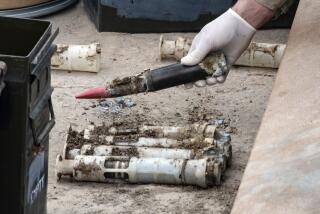War’s Depleted Uranium
- Share via
Contrary to implications in Deborah Blum’s “A Dark Magic in America’s Silver Bullets” (Opinion, June 1) and the accompanying picture, it’s unclear that the depleted uranium remaining after a battle is any more harmful or dangerous than other battle debris. Radiation emitted from DU is so low that it will generally not register on a radiation badge. In other words, you probably couldn’t detect it out of the background radiation that we encounter daily. You’re more likely to be harmed by the radiation you absorb at the beach than you are by being around DU.
The half-life of U-238, which is overwhelmingly the primary isotope of DU, is not 109 years, as stated in Blum’s piece. Rather, it is 4.5 billion years. In other words, half the U-238 that was present when the Earth was formed is still with us, and it is fairly widespread. Uranium occurs naturally in most rocks, and is present in minable quantities in the oceans. U-238 will not sustain a chain reaction. Were the half-life 109 years, there would effectively be no naturally occurring uranium. The next most common isotope in DU, U-235, has a half-life of 700 million years. It, however, is present only in minute quantities, since it was “depleted” from the uranium for power reactors and weapons.
Lead and copper, both of which are used far more in combat than DU, can pose serious environmental problems since they’re both heavy metals, yet one does not hear cries for cleanup of these metals after a war. It’s time to give the whole DU thing a rest.
Burt Hermey
Costa Mesa
*
Blum advocates that the Pentagon clean up the mess it creates with use of depleted uranium penetrators. I applaud the suggestion and join in. Afghanistan needs to be added to Iraq, Bosnia and Kosovo. In addition, NATO, in its 78-day bombing of Serbian infrastructure, created a huge environmental catastrophe. Almost daily attacks on the chemical and petrochemical plants, refineries, fuel storage plants and other plants caused numerous industrial accidents resulting in releases of hazardous chemicals, including the world’s most toxic organic pollutants.
The United Nations Environmental Programme has singled out four sites (hot spots) and launched a modest cleanup project funded by several European countries. The U.S., while causing 80% to 90% of the damage, has contributed nothing thus far. Now that the relations between the U.S. and Serbia and Montenegro have vastly improved, it should be a moral imperative to make good on the illegal destruction caused.
To point out that DU is 40% less radioactive than natural uranium is moot. DU comes in a highly concentrated form and thus more than makes up for its lower alpha activity. Besides, natural uranium is not harmless. The deaths of about 400 Bosnian Serbs in Hadzici (near Sarajevo), bombed in 1994, are linked to DU. Fivefold increases in cancer rates have been reported as well.
Vojin Joksimovich
Escondido
*
Blum’s piece about DU penetrators for antitank warfare shows an almost total lack of knowledge of military requirements and warfare in general. There’s only one question any military needs to ask when it comes to deploying a weapons system: Does it hurt, kill or debilitate the enemy substantially more than it does its own troops? If so, what’s the ratio; 2 to 1, 3 to 1? The ratio is predicated on that particular country’s and military’s regard for life -- both of its own troops and what it takes to defeat the foe. The decision, on occasion, also turns on how desperate a nation is to win or stave off an invader.
Blum herself admits there is absolutely no evidence to support a conclusion that depleted uranium penetrators are harmful to anyone other than those whom they’re launched at. Since she acknowledges this, why did The Times even bother to publish this article? Obviously Blum never was in the military or fought in combat of any type.
Zane Binder
Corona
More to Read
Sign up for Essential California
The most important California stories and recommendations in your inbox every morning.
You may occasionally receive promotional content from the Los Angeles Times.













